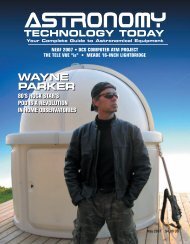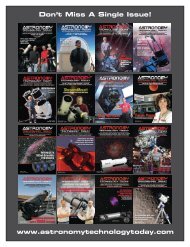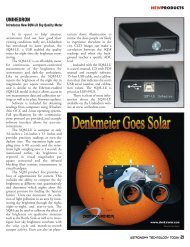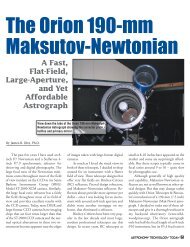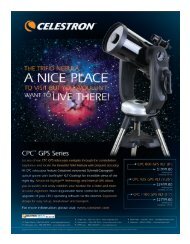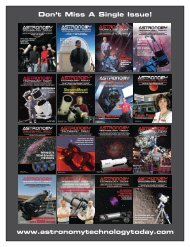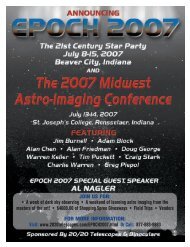magnilux - Astronomy Technology Today
magnilux - Astronomy Technology Today
magnilux - Astronomy Technology Today
You also want an ePaper? Increase the reach of your titles
YUMPU automatically turns print PDFs into web optimized ePapers that Google loves.
PROTOSTAR’S FLOCKBOARD<br />
knife to cut out the focuser hole, and reinstall<br />
the hardware. Collimate and enjoy the<br />
contrast!<br />
No stickiness! No carefully unpeeling<br />
wax paper in terror of an air bubble. No<br />
using a broomstick to reach the middle of<br />
the tube. Cut, roll, spring, poke, cut, enjoy.<br />
Is it that easy I ordered some to find out.<br />
The scope I had in mind to flock was<br />
the Vixen R150s, a 6-inch Newtonian with<br />
a unique sliding focuser and very good optics.<br />
Like most aluminum and steel tubes,<br />
the R150s is painted with a flat(ish) black<br />
paint inside. The scope is a bit short for<br />
the focal length, so the tube doesn’t<br />
serve as much of a baffle. In my light polluted<br />
driveway, it could use all the help it<br />
could get!<br />
Working with the FlockBoard was indeed<br />
as easy as Bryan promised, and it wasn’t<br />
very tool intensive either. I needed a<br />
large flat surface to cut on, a sharp utility<br />
knife, a T-square to cut a perpendicular<br />
line, and a screwdriver to remove the tube<br />
hardware. You can see my workspace and<br />
materials in Image 1.<br />
FlockBoard comes in a standard width<br />
of 24 inches; the length of course can be<br />
custom cut. It turns out that the R150s’s<br />
inner tube wall’s circumference was almost<br />
exactly 24 inches, so I didn’t have to trim<br />
the width and I could use it lengthwise.<br />
Owners of larger-diameter tubes can<br />
order a custom length equal to the inner<br />
circumference and then flock the tube in<br />
24-inch sections, trimming the last piece<br />
to fit.<br />
First, I prepared the tube. This involved<br />
removing the primary mirror and<br />
cell, and the focuser/secondary, which in<br />
the R150s is a single unit. Then, I measured<br />
the length of the tube and placed my<br />
FlockBoard flat on my cutting surface as<br />
shown in Image 2. I immediately noticed<br />
that the cut edges were not square to the<br />
sides…I had a big parallelogram. Bryan<br />
sent me more than I requested, so this didn’t<br />
hurt my plans, though it does mean a<br />
few inches that ProtoStar could have sold<br />
to someone else. So I trimmed the first end<br />
Image 4<br />
so it was square, measured the length from<br />
there and made the final cut. I found that<br />
going over the line twice lightly with the<br />
knife made for a cleaner cut than trying to<br />
cut it in one heavy pass.<br />
Once cut, I rolled the board up and<br />
dropped it into the tube as shown in Image<br />
3. Yes, it’s easy enough that you can do it<br />
one-handed and take a photograph with<br />
the other hand! I had to reroll it a bit a few<br />
times inside the tube to get both ends of it<br />
square against the inner flange of the tube<br />
rings but it was far less effort than any selfadhesive<br />
material I’d tried to use and the<br />
non-adhesive nature of it meant infinite<br />
do-overs. A rarity in life in general.<br />
Because I was flocking from the front<br />
of the tube to just below the face of the primary<br />
mirror, and because there is no separate<br />
spider, I didn’t have to poke any holes<br />
<strong>Astronomy</strong> TECHNOLOGY TODAY 69



